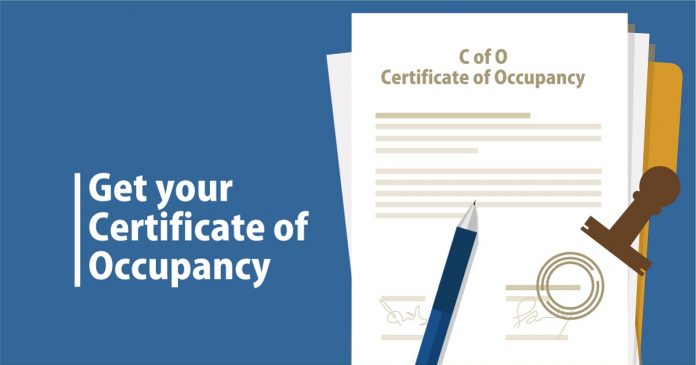Do you know what a Certificate of Occupancy is or why it is deemed the most important document to a land owner or property buyer in Nigeria? A Certificate of Occupancy, also known as the C of O is a document issued by state governments in Nigeria to landowners and property buyers as a legitimate proof of ownership. This document also spells out what the land can be used for; residential, commercial or mixed development.
The government is constitutionally mandated to issue the Certificate of Occupancy because all lands in the state are vested in the Governor of the State. This is clearly spelt out in the Land Use Act 1978.
But why is it so important? A parcel of land or property without a Certificate of Occupancy is as good as owning a vehicle without a logbook. This is not the kind of situation you want to find yourself as a landowner or property owner in Nigeria.
In this article, we will shed light on everything you need to know about the Certificate of Occupancy (C of O) in Nigeria; including how to obtain one for different kinds of land and property.

It Matters Who You are Buying Land from
The individual or entity that you are buying the land or property from determines how you will get your Certificate of Occupancy. If you are buying from natives, also known as ‘Omo Onile’ in Lagos, you have to first ensure that the land or property you are about to buy has not been acquired by the government.
When you have confirmed from the authorities that the land being sold to you is legally owned by the seller, then you should find out if the owner already has a Certificate of Ownership for the land or property.
The second entity that is legally authorised to sell land to you is the state government. If you are buying straight from the government, the process of obtaining your C of O would be initiated as soon as the sale is confirmed.

Steps to Obtaining C of O for State-Owned Land
Obtaining a Certificate of Occupancy requires following a clearly spelt out procedure that takes a minimum of 21 working days. It is important to find out for sure that your land or property is not already under acquisition. Take a look at the steps below:
- Applicant purchase and submit application pack to Land Use Allocation Committee (LUAC)
- Applicant collects acknowledgement slip
- Applicant collects letter of offer of allocation (1 day)
- Applicants pay for allocated land (within 90 days)
- Applicant is issued a letter of confirmation with plot and block number (Note that full payments must be made before Plots & Blocks are allocated)
- The Scheme Officer processes application for C of O
- The Scheme Officer signs off on the file and forwards files to Executive Secretary LUAC (5 days)
- The Surveyor General provides Scheme Officer with digitised survey (2 days)
- The Executive Secretary LUAC approves processing and signs letter of allocation
- The Executive Secretary LUAC signs off on the file
- The Executive Secretary LUAC sends file to the Senior Special Assistant (SSA) to the Governor on Lands (2 days)
- The Senior Special Assistant (Lands) vets entire file and sends file/application with a covering memo to the Permanent Secretary (PS) Lands Bureau (2 days)
- If file has a query, message is relayed back by notification; PS Lands signs off on the memo and sends file to Governor (2 days)
- The Governor approves file and electronically signs the C of O (2 days)
- If the file has a query, a message is relayed back by notification.
- Upon approval and signing of C of O, the Governor signs off and sends file to the Deputy Registrar for further processing (2 days)
- The Deputy Registrar processes file further, signs off and send the file to the Registrar of Titles for final registration (2 days)
- The Registrar of Titles registers the C of O, signs off and request for printing of C of O (1 day)
The state government has warned landowners and property owners to be wary of fake and cloned Certificates of Occupancy.
Documents You Need for a State-Owned Land
To obtain a Certificate of Occupancy for a state-owned land, you need the following:
- A formal Letter addressed to the Executive Secretary – Land Use and Allocation Committee located at Block 13, Room 4, Lands Bureau, The Secretariat, Alausa in Ikeja
- A Standard Allocation Form with receipt – Lekki Peninsula Schemes, Abijo Commercial and Industrial (Form for Prime Land); other areas (Form for General);
- Four passport photographs with white background
- Evidence of Income Tax payment
- Current development levy (For companies, you need evidence of payment of Income Tax of Two Directors and Development Levy)
- A survey plan
- All payment receipts of Land Charges
- Vital Information Form
How to Obtain C of O for Non-State-Owned Land
The process of obtaining a non-state-owned land is different from what obtains for state-owned land. For non-state-owned lands, follow the steps below:
- Submit Application and Vital Information Form for Certificate of Occupancy. Applicant’s name is compiled for publication
- Title Search for previous Registration and Site Inspection (21 days)
- Certificate of Occupancy Engrossment (by Land Use Allocation Committee)
- Recommendation for execution of Certificate of Occupancy (by Executive Secretary Land Use Allocation Committee, Senior Special Assistant Lands & Permanent Secretary Lands)
- Execution of Certificate of Occupancy (by Governor)
- Stamp Duty (by Commissioner for Stamp Duties); Registration of Certificate of Occupancy (by Land Registry); and Collection of executed and registered Certificate of Occupancy (by you)
Documents you Need for a Non-State-Owned Land
If you just acquired a non-state owned-land, you need the following documents to obtain a Certificate of Occupancy:
- A formal Letter addressed to the Executive Secretary Land Use Allocation Committee located at Block 13, Room 4, Lands Bureau, The Secretariat, Alausa in Ikeja
- A completed Certificate of Occupancy Form with receipt
- A Land Information Certificate with receipt
- Four original Survey Plan (2 in cloth and 2 in paper)
- Four passport photograph with white background
- A sketch map of the site Location
- Duly stamped purchase receipt
- Evidence of payment of Income Tax
- Current development levy (In the case of a company, you need 2 Directors Tax Clearance and development levy)
- A Publication Fee of N10,000.00
- Capital contribution fee subject to a minimum of N30,000.00
- Building plan approval if developed
- A copy of Tenement Rate receipt (if the property is occupied)
 Benefits of Having a Certificate of Occupancy for your Land
Benefits of Having a Certificate of Occupancy for your Land
Obtaining a Certificate of Occupancy goes deeper than merely granting you ownership of the land. It also:
- Makes the person named on the document the exclusive owner of the land
- Prevents a situation where a single property is claimed by multiple owners
- Prevents the government from repossessing the land or property, but this is ultimately subject to the overriding control of the state government
- It is an acceptable as a security or collateral for loans from banks and other financial institutions
- It is a widely used to resolve land disputes that arise from ownership tussle
- It is a very crucial document during mortgage transactions
The Electronic Certificate of Occupancy
In 2015, the Lagos State Governor, Akinwunmi Ambode approved the release of Electronic Certificates of Occupancy and it has since been officially adopted. Prior to the approval, advertised schedule had been published in several publications.
To collect their C of O, the allottees listed in the schedule were expected to visit the Lands Bureau at the Alausa Secretariat in Ikeja for the collection of their Certificates of Occupancy.
The electronic Certificate of Ownership contains and transactional page, which shows all transactions that have taken place on the land. The good thing about this is that it allows you to assess the history of any land in question.

How do Scammers Trick Unsuspecting Landowners?
There are tricks that scam artists use in luring unsuspecting landowners and property buyers into their net. One way they do this is by cloning and forging Certificates of Occupancy. Some of them even go as far as using the fake certificates to obtain loans from banks and other credit finance organisations.
Many of those who perpetrate this fraud do it through third Legal Mortgages, which is executed without the need for the physical appearance of a guarantor. The end goal of this scam is to obtain bank loans without collateral.
There is, therefore, a need to carry out proper authentication of Certificates of Occupancy from the authorised government agency.
Final Thoughts
The electronic certificate does not in any way render the former yellow version worthless. it remains a very valuable land instrument and can be used as a legitimate document to conduct land and property related transactions until the time when they can be exchanged for the electronic copy of the certificate of ownership.









